As part of traffic violation enforcement measures, 600 buses operated by OSY will be equipped with digital cameras that use artificial intelligence, aimed at both recording road network problems and monitoring violations in bus lanes. MP Konstantinos Kyranakis emphasized that “we are not looking to punish, but to respect people waiting for buses,” highlighting the system’s goal to ensure smooth vehicle movement and citizen safety.
OSY has already announced a tender for the “Road Network and Traffic Conditions Recording and Analysis System, Traffic Flow and Traffic Violations with Special Electronic Devices (Fixed Cameras)” worth over 1.56 million euros, with a 12-month implementation timeline. Bid submissions close on December 8, 2025, with opening scheduled for December 11. The system is already being piloted on 10 Athens bus routes, recording illegal vehicle intrusion into bus lanes, illegal parking, and other violations, while providing valuable data on road network conditions.
Kyranakis: “Technology gives us the ability to have consistent schedules, shorter travel times and a level of control that enhances road safety for everyone”
As stated to APE-MPE, Deputy Transport Minister Konstantinos Kyranakis said the 600 new cameras to be added to the existing pilot camera fleet will strengthen a measure that is already working. “The more we protect bus lanes from illegal use, the faster buses move, and this is something citizens feel immediately at bus stops,” he emphasized.
“Surveillance is not done to ‘ticket’ as many drivers as possible. It’s done to ensure proper functioning of a network that serves hundreds of thousands of people daily. The first cameras have been installed pilot-wise on 10 buses and the algorithm has been trained. The tender for 600 cameras is underway, the Attica Region is proceeding with its own fixed camera installation, and together with the Ministry of Digital Governance we are completing the unified information system that will handle all violations with accuracy and transparency. Technology gives us the ability to have consistent schedules, shorter travel times and a level of control that enhances road safety for everyone. We don’t punish, we respect people who wait daily for buses to get to work, home, or their obligations,” the deputy minister noted.
Buses enhanced with AI cameras – How the system will work
The system will collect, store and analyze real-time data on: traffic conditions and vehicle flow, road infrastructure conditions (e.g. damage, potholes, cracks), and traffic violations committed around buses, such as illegal stopping, red light violations, or vehicles moving in bus lanes.
Specifically, the project’s purpose, as noted in the tender, is to optimize OSY’s network operation, enhance passenger and driver safety, reduce operational costs, and immediately inform relevant authorities about incidents requiring intervention. Additionally, the project aims to collect valuable data for route improvement, congestion point identification, and sustainable mobility policy development.
The system installation relies on cutting-edge technologies, including high-resolution digital cameras capable of operating day and night, recording images and videos with precision, IoT (Internet of Things) sensors that will collect real-time data, artificial intelligence (AI) algorithms and machine vision for automatic recognition of objects, vehicles and violations, while the system will feature a cloud-based management platform through which OSY staff can monitor, analyze and visualize data.
The system software will convert multiple video streams into analytical elements, while offering traffic prediction capabilities and early notification for traffic incidents or road network problems.
The central platform will constitute the system core and will include four basic subsystems:
- Driver behavior assessment and traffic violation detection: Will identify and record real-time violations such as illegal stopping, traffic light violations, or bus lane circulation with tickets sent directly to citizens’ digital mailboxes.
- Multiple vehicle and fleet monitoring: Will provide live images of buses and traffic through interactive maps.
- Road artery structural health assessment: Will recognize damage, cracks and anomalies, classifying them according to severity.
- Statistics and data visualization: Will present all findings through charts, tables and heat maps.
The artificial intelligence algorithms used have been trained with real traffic data, enabling the system to recognize and classify different vehicle types (cars, trucks, motorcycles, buses).
Based on collected data, critical metrics will be calculated including: number and speed of vehicles per category, average delay time, congestion levels, and CO2 emissions per traffic flow. This data will be displayed through heat maps, allowing the organization to identify problematic network points early. This technology will help not only in better fleet management but also in policy decision-making for urban mobility improvement.
The new system is expected to enhance driver and passenger safety, improve service quality, while simultaneously reducing delays and operational costs with parallel road infrastructure improvement, thanks to damage analysis and road structural health assessment.
Through the platform, OSY staff will be able to monitor in real-time each bus’s position and condition, recorded violations, and areas with increased congestion or poor road conditions. All data will be available with statistical export capabilities, search filters and historical records.
The application comes as a result of Article 107 of the new Traffic Code, which allows traffic violation detection through special electronic devices and cameras, provided there is clear public warning.
OSY’s system will operate exclusively as a recording device, automatically sending data to relevant authorities without any analysis or intervention from the organization. Additionally, OSY has initiated GDPR compliance procedures for both its staff and citizens, ensuring data collection and processing will be conducted with full privacy respect, as noted in the tender.
The new system will be able to interoperate with Public Sector information systems, specifically the Transport Ministry’s Vehicle Registry, AADE’s tax registry, the Interior Ministry’s Citizens Registry, and the National Communication Registry (EMEp). It’s designed to be expandable, so it can recognize new violation categories in the future, such as speeding, pedestrian crossing violations, or reckless driving.
The estimated contract value breaks down to 900,000 euros (1.116 million euros with VAT) for basic work and 360,000 euros (446,400 euros with VAT) as an option right for possible physical object expansion up to 40% of the original budget.
Contract duration is set at 12 months, with possible extension if installation or equipment supply isn’t fully completed. Pilot operation will allow system parameter adjustment to actual needs, while OSY staff will be trained in platform and analysis tool usage by the project contractor.




